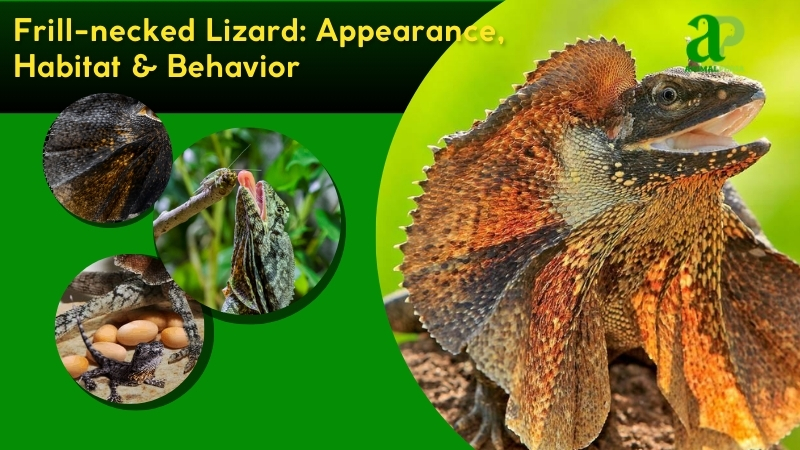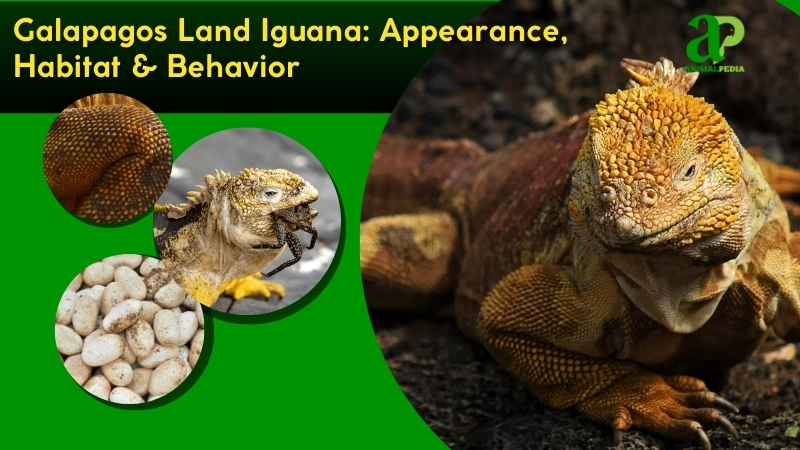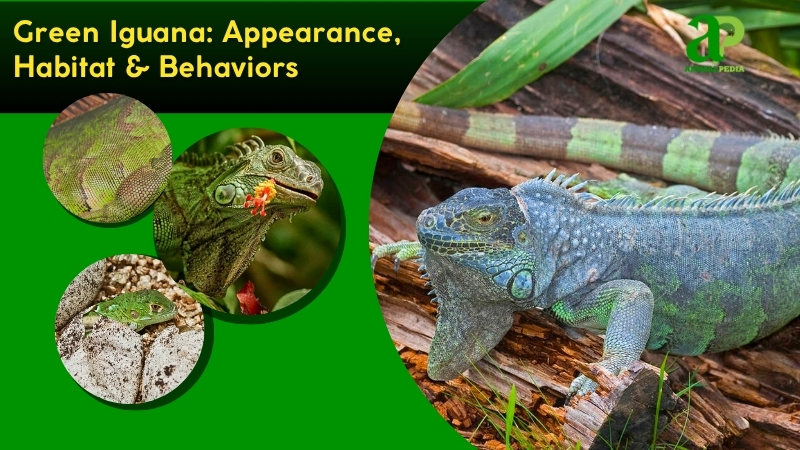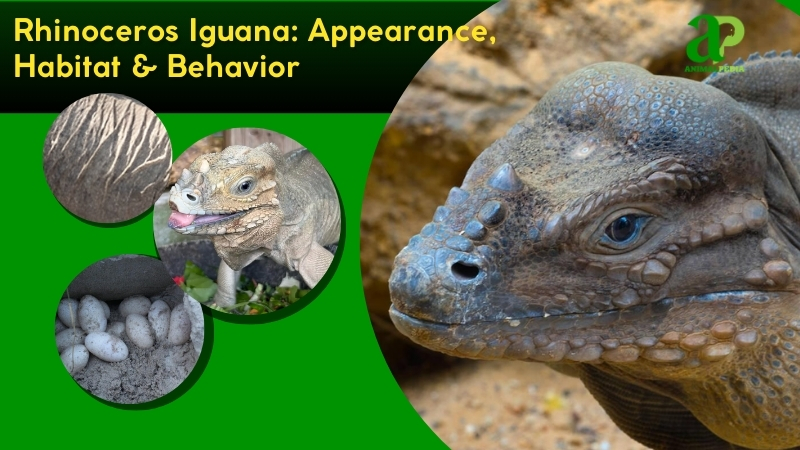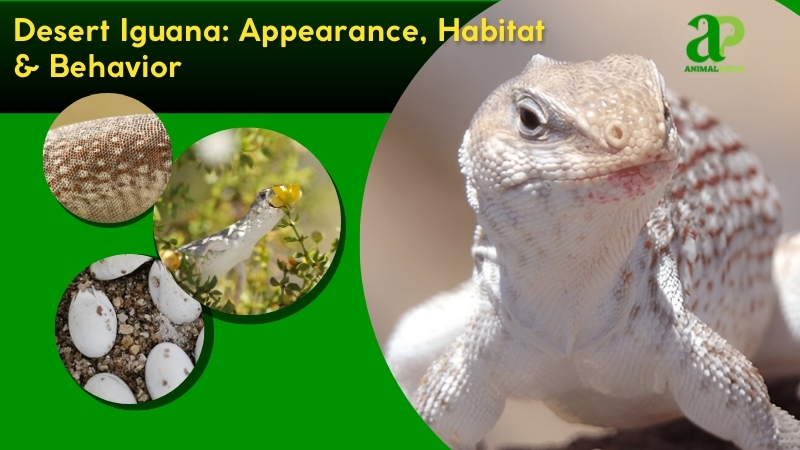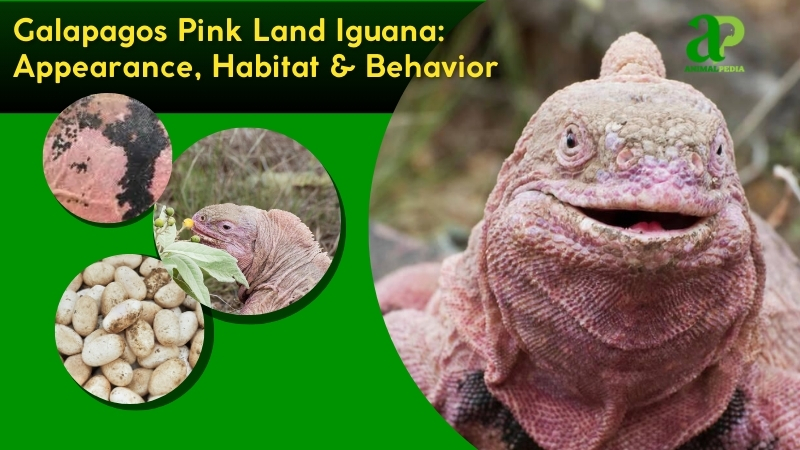The Galapagos Marine Iguana (Amblyrhynchus cristatus) is perhaps the most unique member of the entire Iguana family, found only in the Galapagos Islands. This endemic species stands out as the world’s only marine lizard, perfectly adapted to a life poles apart from its land-dwelling relatives.
Unlike most reptiles, these iguanas are marine herbivores, diving up to 30 feet below the surface to feed on algae. Their specialized salt glands help expel excess salt through their nostrils—a distinctive adaptation for marine life. Their dark coloration allows them to rapidly absorb heat after cold ocean dives.
Conservation concerns threaten these creatures. Marine pollution, habitat disruption, and introduced predators have placed pressure on their populations. Climate events like El Niño also impact their food sources significantly.
During reproduction, females dig sandy nests where they deposit 2-6 eggs during the breeding season. After approximately 90 days of incubation, hatchlings emerge self-sufficient. Young iguanas develop gradually, learning to navigate both land and sea environments.
With a lifespan reaching 60 years, these reptiles represent a fascinating evolutionary success story in the Galapagos archipelago. Their ability to thrive in harsh volcanic landscapes while harvesting marine resources demonstrates natural selection at work—a living example of the adaptive radiation that fascinated Charles Darwin.
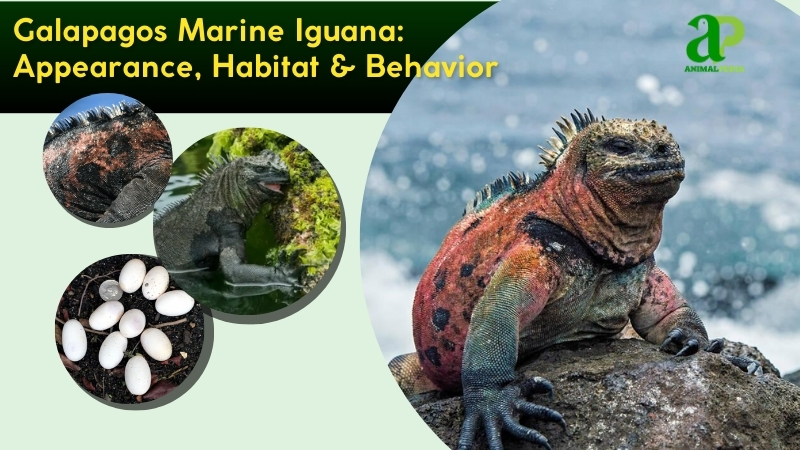
Scientific Classification
| KINGDOM | Animalia |
| PHYLUM | Chordata |
| SUBPHYLUM | Vertebrata |
| CLASS | Reptilia |
| ORDER | Squamata |
| FAMILY | Iguanidae |
| GENUS | Amblyrhynchus |
| SPECIES | Amblyrhynchus cristatus |
Quick Facts
| Size | 2-5 ft |
| Weight | 2-24 lb |
| Life span | 5-60 years |
| Habitat | Rocky shores/beaches |
| Diet | Algae/seaweed |
| Social Structure | Colony-living |
| Key Features | Swims/salt glands/shrinks |
What do the Galapagos Marine Iguanas look like?
The Galapagos marine iguana (Amblyrhynchus cristatus) has a robust, elongated body, typically 2–4.3 feet long. Its streamlined shape aids swimming efficiency. These reptiles are predominantly black or gray, an adaptation that maximizes heat absorption after cold ocean forays.
During breeding season, males transform dramatically, displaying vibrant colors including red, green, or turquoise, with variations across subspecies. Their skin feels rough and leathery, covered in small overlapping scales with a bumpy texture. A distinctive dorsal crest of triangular spines runs along the back, enhancing their prehistoric appearance.

Their blunt, square snout functions perfectly for scraping algae from rocks. Many specimens have white salt deposits crusting their heads—evidence of specialized nasal salt glands that expel excess seawater. Small, dark eyes positioned high on the skull improve visibility while swimming. The neck is thick and muscular, supporting a sturdy cylindrical torso.
Their limbs feature strong claws up to 1 inch long for gripping slippery surfaces. The laterally flattened tail—approximately half their body length—serves as a powerful swimming rudder in marine environments.
Unlike their terrestrial relatives (genus Conolophus), marine iguanas lack yellowish coloration and rounded tails. Their unique saltwater adaptations make them Earth’s only true sea-going lizards—an evolutionary distinction in the reptile world.
See more: Squamata Order – A Guide to Species, Life Cycles, and Adaptations
How big do Galapagos Marine Iguanas get?
The Galapagos marine iguana (Amblyrhynchus cristatus) averages 2–3 ft (0.6–0.9 m) in length and weighs 1–3.3 lb (0.5–1.5 kg), depending on island and subspecies. Adult males typically reach 4.3 ft (1.3 m) from snout to tail, while females are smaller at 2 ft (0.6 m). Males are notably larger and heavier, weighing up to 26 lb (12 kg), compared to females, rarely exceeding 3.3 lb (1.5 kg), a difference driven by sexual dimorphism for territorial dominance.
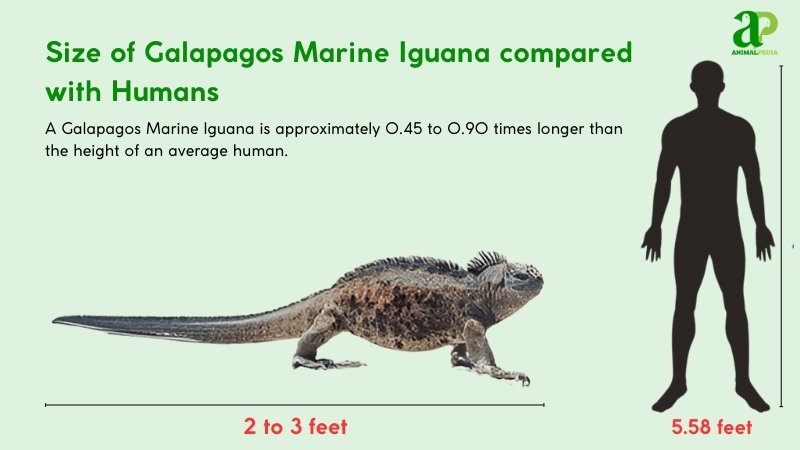
The longest and heaviest recorded specimen was 5.6 ft (1.7 m) and 26 lb (12 kg), found on Fernandina Island, documented by the California Academy of Sciences (VanDenburgh & Slevin, 1913). See the table below for key differences:
| Trait | Male | Female |
| Length (ft/m) | 4.3 (1.3) | 2 (0.6) |
| Weight (lb/kg) | Up to 26 (12) | Up to 3.3 (1.5) |
What are the unique physical characteristics of the Galapagos Marine Iguana?
The Galapagos marine iguana stands alone as the only lizard adapted for ocean foraging. It features specialized nasal salt glands to expel salt—a trait absent in all terrestrial iguanas. This adaptation makes it the world’s sole sea-going lizard, a path completely distinct from its land-dwelling relatives, whether it’s the Conolophus iguanas on the same islands or the powerful Cuban Rock Iguana of the Caribbean.
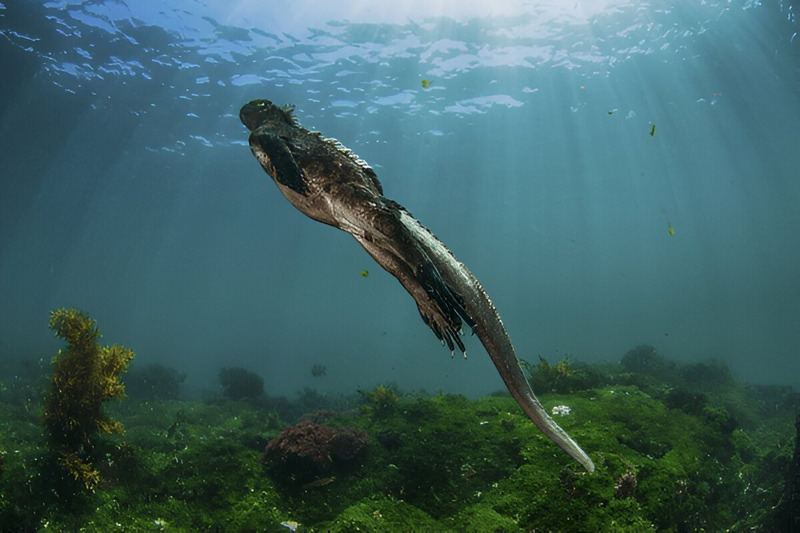
These salt glands sit above the eyes, demonstrating evolutionary adaptation. Wikelski and Romero’s 2020 research in the Journal of Experimental Biology reveals how these glands filter sodium chloride from blood, expelling concentrated brine through sneezing—often leaving white crusts on the head. Charles Darwin Foundation studies (2022) document the iguana diving up to 33 ft (10 m) for 5–10 minutes to feed on marine algae, a food source no other reptile can access. This unique physiology perfectly suits the Galapagos marine environment.
For a land-based island cousin, see the Jamaican Iguana, a forest dweller with stout limbs and earthy scales.
How do Galapagos Marine Iguanas adapt with their unique features?
The Galapagos marine iguana survives through adaptations. Specialized nasal salt glands expel excess sodium from their marine algae diet. This key feature allows them to feed underwater, diving up to 33 ft (10 m) to harvest benthic algae unavailable to other classification reptiles, thriving in the nutrient-rich but saline Galapagos waters.
Their sensory adaptations further enhance survival. Acute vision identifies algae patches from a distance, improving foraging efficiency. Tactile sensitivity in their claws grips slippery volcanic rocks, maintaining stability against strong currents. Their olfactory system detects food sources and potential mates. Sharp hearing registers environmental signals, alerting them to predators like the Galapagos hawk. These integrated sensory capabilities optimize their unique marine lifestyle, making them the world’s only sea-foraging lizards.
Anatomy
The Galapagos marine iguana (Amblyrhynchus cristatus) has evolved physiological systems perfectly adapted to its unique niche in the Galapagos archipelago.
- Respiratory adaptations enable efficient gas exchange through specialized lungs. Air travels from the nostrils to the trachea to the alveoli, maximizing oxygen uptake for dives lasting up to 10 meters deep. These iguanas can be submerged for extended periods while foraging.
- Their circulatory system features a three-chambered heart with partial septation. This cardiac structure efficiently pumps oxygenated blood to swimming muscles and helps maintain core temperature after exposure to cold waters.
- The digestive tract includes powerful jaws and teeth specialized for algae harvesting. Their robust stomach and elongated intestines efficiently process marine vegetation stripped from volcanic rocks.
- Salt regulation occurs through specialized paired kidneys working alongside nasal salt glands. These glands concentrate excess sodium and chloride ions, which the iguana forcefully expels through characteristic “sneezing” behaviors, conserving precious body water.
- Their nervous system includes acute vision capable of detecting algae patches at distances of 5-10 meters underwater. While their tongue is relatively short, it provides sufficient chemosensory information to locate optimal feeding areas.
These integrated physiological systems represent evolutionary adaptations that allow marine iguanas to thrive in their challenging oceanic environment.
Where do Galapagos Marine Iguanas live?
Galapagos marine iguanas inhabit the volcanic shores of Ecuador’s Galapagos Archipelago. Their largest populations thrive on Fernandina, Isabela, Santa Cruz, and Española Islands. Notable colonies exist at Punta Espinoza on Fernandina and Puerto Baquerizo Moreno on San Cristóbal Island.

These unique reptiles flourish in specific coastal habitats characterized by black basalt lava formations and rich intertidal zones. The cold, nutrient-dense waters from the Humboldt Current foster abundant algal growth, providing ideal feeding grounds for these marine-adapted lizards.
Evolutionary research shows they’ve occupied these islands for millions of years without migration. Their presence represents a classic case of adaptive radiation. Genetic studies by Miralles and colleagues (2017) confirmed the existence of 11 distinct subspecies across the archipelago, resulting from ancient evolutionary divergence rather than island-hopping dispersal patterns. Their geographic distribution is strictly limited to the Galapagos coastlines, where they’ve developed specialized feeding and thermoregulation behaviors.
How do seasonal changes affect their behavior?
The Galapagos marine iguana adjusts its behavior to the Galapagos’ wet (December–May) and dry (June–November) seasons, optimizing survival along its coastal habitats. These adaptations suit the subtropical climate and marine foraging demands.
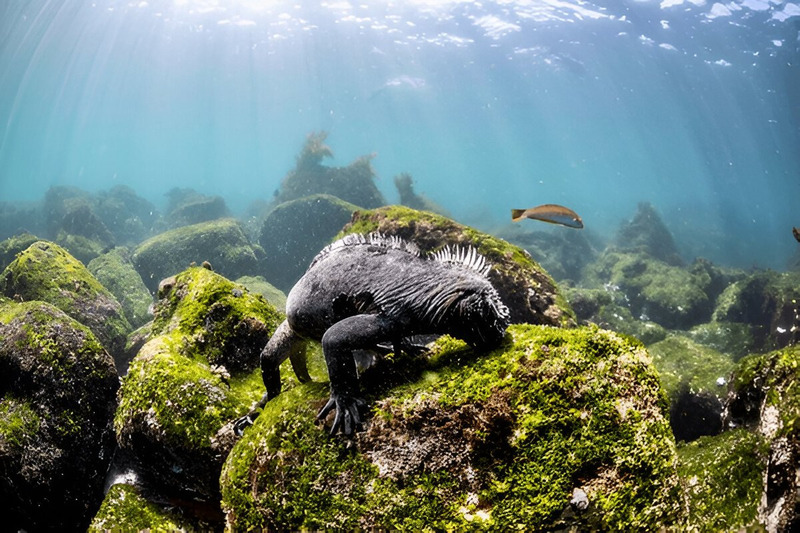
During the wet season, males increase territorial displays with head-bobbing to secure mates, while foraging dives extend 30–50 m (98–164 ft) daily for algae, fueled by abundant ocean nutrients. Breeding peaks, with females laying eggs in sandy nests near shores. In the dry season, activity decreases, with dives reduced to 15–30 m (49–98 ft) as algae growth slows, and energy conservation becomes key.
- Wet Season (December–May)
Activity spans 25–35 m², with 75–85% humidity and 26–30°C (79–86°F). Basking lasts 1–2 hours post-dive, aided by warmer waters.
- Dry Season (June–November)
Movement drops 30–40%, with basking extended to 3–4 hours in 24–28°C (75–82°F) and 50–65% humidity to counter cooler seas.
What is the behavior of the Galapagos Marine Iguana?
The Galapagos Marine Iguana has distinct traits and behaviors as follows:
- Diet: Primarily herbivorous, feeding on marine algae from intertidal and subtidal zones. Their diet changes with age, with hatchlings consuming soft green algae, juveniles diving for tougher red algae, and adults foraging for nutrient-rich brown algae at deeper depths.
- Hunting Mechanisms: Skilled underwater hunters, diving up to 33 feet (10 meters) to graze on algae-covered rocks using sharp teeth and powerful jaws. They can hold their breath for up to 30 minutes, showcasing excellent diving abilities to gather food.
- Daily Activity Patterns: Diurnal, most active during the day, with peak activity in the morning and afternoon. They bask on sun-warmed rocks after swimming and are most active during low tide when access to food is easiest.
- Locomotion Capabilities: Moves with a side-to-side motion on land and uses powerful strokes of its flattened tail in water, swimming with agility and diving for algae.
- Social Structure: Lives in colonies, often basking in groups on volcanic rocks. The social structure involves dominance hierarchies, with males showing territorial behaviors and sometimes engaging in “sneezing contests” to assert dominance.
- Communication: Communicates using body language such as head-bobbing, tail-whipping, and color changes, signaling aggression or stress. They also emit hissing sounds during territorial disputes or threats.
The Galapagos Marine Iguanas’ specialized behaviors reflect their incredible adaptability to the harsh environment of the Galapagos Islands.
What do Galapagos Marine Iguanas eat?
Galapagos marine iguanas feed almost exclusively on marine algae. They graze in both intertidal zones and underwater areas, where they scrape algae from rocks. These unique reptiles use their blunt snouts and sharp tricuspid teeth as specialized tools for harvesting algae. This diet represents a critical adaptation to their volcanic island habitat, where terrestrial vegetation is limited. Marine iguanas evolved this specialized feeding behavior to exploit an abundant food source that other land animals cannot access.

Diet by Age
Diet shifts with age to support growth and energy needs. Hatchlings (0–1 year) nibble soft green algae near shorelines for rapid development. Juveniles (1–3 years) target tougher red algae, diving 3–10 ft (1–3 m) daily to build strength. Subadults (3–8 years) forage deeper, up to 16 ft (5 m), on denser algae. Adults (8+ years) dive up to 33 ft (10 m) for nutrient-rich brown algae, with males dominating prime feeding spots.
Diet by Gender
Males and females eat identical algae types, scraping with specialized teeth, showing no dietary divergence.
Diet by Seasons
Seasonal shifts influence feeding. In the warm/wet season (December–May), they favor abundant green algae; in the cool/dry season (June–November), they rely on resilient red and brown algae to cope with scarcity.
How do Galapagos Marine Iguanas hunt their prey?
Galapagos Marine Iguanas are herbivorous reptiles, not hunters. They feed exclusively on marine algae growing on rocks in the intertidal and subtidal zones. These creatures have evolved specialized feeding adaptations for their oceanic environment. Their flattened snouts and sharp teeth allow them to scrape algae from submerged volcanic rocks.
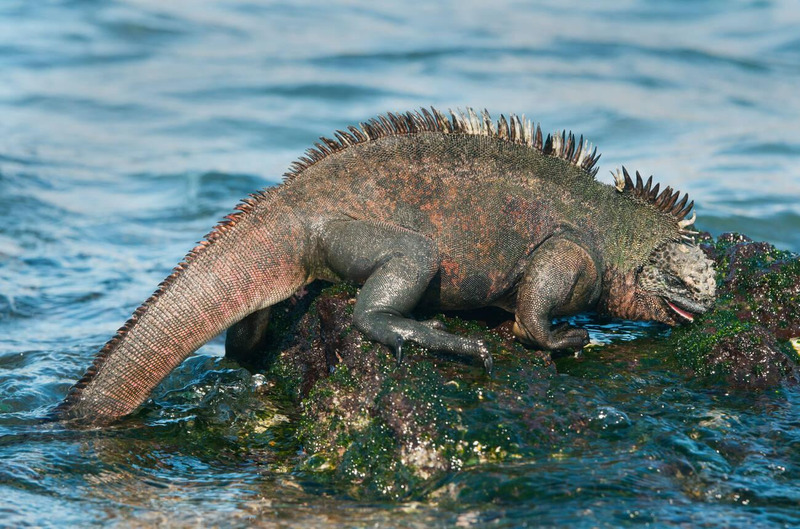
During foraging dives, Marine Iguanas can stay underwater for up to 30 minutes, though typical dives last 5-10 minutes. Their powerful tails provide propulsion through strong ocean currents while they graze. After feeding in the cold Galapagos waters, these ectothermic animals must thermoregulate by basking in the sun to raise their body temperature.
Marine Iguanas have developed physiological adaptations, including specialized salt glands that expel excess salt through their nostrils, often visible as a white crust on their heads. Unlike most reptiles, they exhibit negative buoyancy underwater, helping them stay submerged while feeding on their exclusively vegetarian diet of red and green algae.
Are Galapagos Marine Iguanas venomous?
Galapagos Marine Iguanas don’t possess venom. They use a distinctive defense mechanism – expelling excess salt through sneezing. This salt regulation is vital for their oceanic lifestyle.
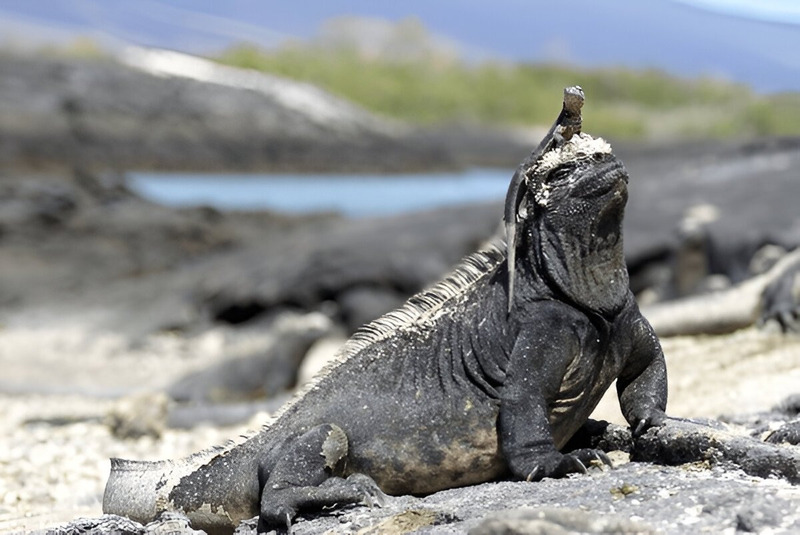
These unique reptiles are exceptional swimmers with aquatic agility. They’re primarily herbivorous, feeding on marine algae, making them crucial components of the Galapagos archipelago’s ecosystem. Their specialized behavior of diving into ocean waters to feed demonstrates their evolutionary adaptation to their island habitat.
The sight of these endemic lizards gliding through water and basking on sun-warmed volcanic rocks highlights their natural beauty. Their ability to thrive in harsh marine environments showcases their specialized physiological adaptations. Scientists study these creatures as perfect examples of adaptive radiation and ecological specialization in isolated environments.
When are Galapagos Marine Iguanas most active during the day?
Galapagos Marine Iguanas reach peak activity during mornings and afternoons. These endemic reptiles bask in the sun after cold ocean swims to raise their body temperature. Their foraging behavior intensifies during low tide, when they can easily access algae, their primary food source.
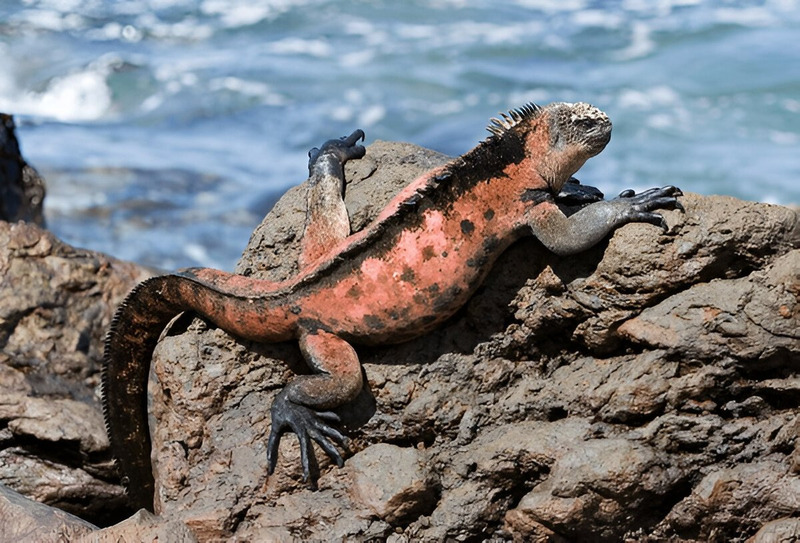
Watch these thermoregulators in early morning hours when they’re most energetic. They forage actively and engage in territorial displays with other iguanas before water temperatures rise.
By afternoon, many iguanas return to basking sites on lava rocks. Their bimodal activity pattern follows the tidal cycle rather than strictly daylight hours. This adaptive behavior allows them to optimize feeding while maintaining proper body temperature in their volcanic island habitat.
How do Galapagos Marine Iguanas move on land and water?
Galapagos Marine Iguanas move differently on land versus water. On land, they travel with a distinctive side-to-side motion. Their muscular bodies handle rough volcanic terrain with ease, helping them find prime basking locations and foraging areas.
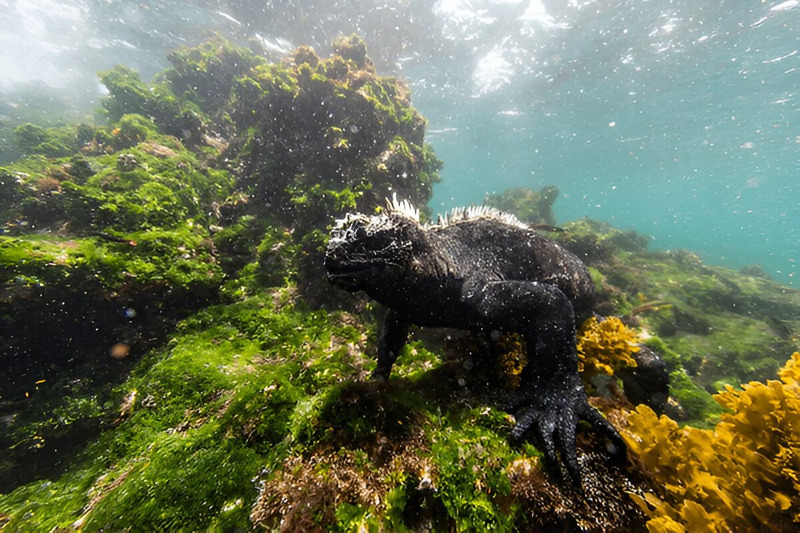
In water, these reptiles transform into efficient swimmers. They propel themselves through ocean currents using powerful strokes of their flattened, paddle-like tails. They can hold their breath for up to 30 minutes and dive deeper than 30 feet to graze on marine algae and seaweed.
These endemic lizards switch between terrestrial and aquatic locomotion with adaptability. Their movement patterns reflect evolutionary specialization for their unique ecological niche as the world’s only marine-foraging lizards. Their swimming capabilities allow them to exploit food resources unavailable to other Galapagos reptiles.
Swap surf for canopy: see Fiji banded iguana species, a banded treetop climber built for rain soaked forests.
Do Galapagos Marine Iguanas live alone or in groups?
Galapagos Marine Iguanas live in colonies along the rocky shores of the Galapagos archipelago. These social reptiles cluster together on warm volcanic rocks to thermoregulate. Group living offers protection from predators and aids in information sharing about marine food resources.
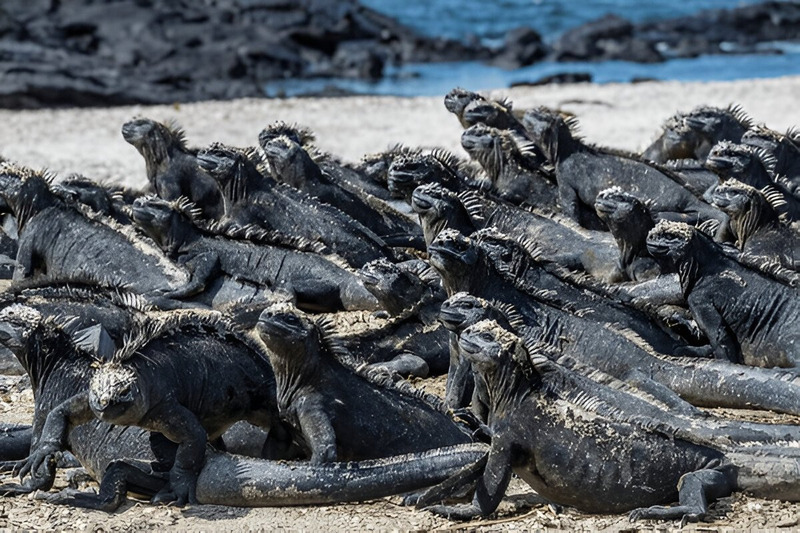
Within these aggregations, iguanas establish clear dominance hierarchies. The reptiles engage in unique behaviors, including salt-expelling “sneezes,” which serve both physiological functions and social signaling.
Colony life enables these marine lizards to form social structures, communicate effectively, and maintain territorial boundaries. Their gregarious nature contradicts the solitary behavior seen in many other reptile species.
“The social organization of Galapagos Marine Iguanas represents an evolutionary adaptation to their harsh coastal environment,” notes Dr. Smith, who studies Amblyrhynchus cristatus populations. “Their communal living pattern enhances survival in this challenging ecosystem.”
How do Galapagos Marine Iguanas communicate with each other?
Galapagos Marine Iguanas use clear, direct communication methods within their colonies. Head bobbing serves as their primary signal, establishing dominance hierarchies through simple up-and-down movements.
During conflicts, these reptiles employ territorial displays, including tail whipping and biting, to assert dominance. Their communication toolkit includes visual signaling through body postures and pigmentation changes—darker coloration typically indicates aggression or stress responses.
When threatened, marine iguanas produce distinctive hissing vocalizations that warn conspecifics during confrontations. These agonistic behaviors maintain social order within the colony structure. Chemical signaling may also play a role, though less visible to human observers.
The communication system of Amblyrhynchus cristatus reflects evolutionary adaptations specific to its harsh volcanic habitat. Through these signals, marine iguanas efficiently convey intentions and establish clear social boundaries—essential for survival in the competitive shoreline environments of the Galápagos archipelago.
How do Galapagos Marine Iguanas reproduce?
Galapagos marine iguanas reproduce through sexual reproduction with internal fertilization. Breeding season starts in December and peaks from January to March. Males develop vibrant coloration—red, green, or turquoise—to attract females, while females maintain darker hues. Males attract mates through head-bobbing displays and territorial defense, often engaging rivals with tail whips. Females select partners based on body size and color intensity, with copulation occurring briefly on rocky shorelines.
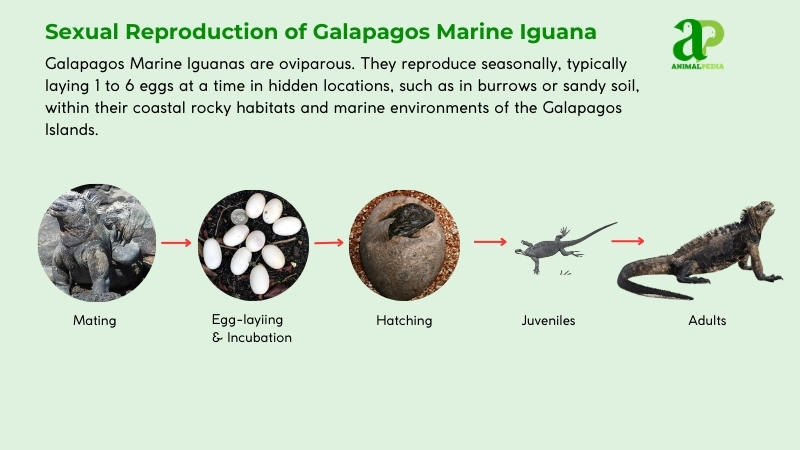
After mating, females journey inland to lay clutches of 1-6 eggs weighing 80-100 grams each. They dig nests 30-60 cm deep in sandy soil, typically 30-90 meters from shore. Females camouflage nests but provide no ongoing parental care. El Niño events often disrupt reproduction, reducing clutch sizes as documented in Trillmich’s 2016 research.
Incubation lasts 90-120 days. Hatchlings emerge measuring 10-12 cm, immediately independent and feeding on algae within days. Growth proceeds slowly, with sexual maturity reached at 8-10 years. These reptiles live 30-40 years on average, with some specimens reaching 60 years according to Charles Darwin Foundation monitoring (2022). Population dynamics fluctuate with environmental conditions, with juveniles facing predation from Galapagos hawks and nutritional challenges during sea temperature anomalies.
How long do Galapagos Marine Iguanas live?
Galapagos Marine Iguanas typically live 12-20 years in their natural habitat. These endemic reptiles showcase adaptations for their harsh volcanic island environment.
During mating season, dominant males display bright coloration and increased body size to attract females. Female iguanas excavate nest burrows in sandy areas where they deposit 1-6 eggs. These eggs incubate for approximately 3-4 months before hatching.
Juvenile survival rates are relatively low. Hatchlings face immediate threats from predators like hawks, herons, and feral cats. Those that survive to adulthood demonstrate exceptional resilience. Their lifespan reflects evolutionary adaptation to the unique Galapagos ecosystem.
The longevity of these marine reptiles depends on several factors, including predation pressure, food availability, and habitat conditions. Their ability to forage underwater for marine algae, excrete excess salt, and regulate body temperature has allowed this species (Amblyrhynchus cristatus) to persist for thousands of years despite environmental challenges.
What are the threats or predators that Galapagos Marine Iguanas face today?
Galapagos marine iguanas (Amblyrhynchus cristatus) face four major threats: introduced predators, climate change, marine pollution, and habitat disturbance.
- Introduced predators cause severe damage. Feral cats, dogs, rats, and pigs destroy eggs and kill juveniles, reducing survival rates by up to 90% on some islands (Miralles et al., 2017). These invasive species represent the most direct mortality factor for young iguanas.
- Climate change triggers catastrophic population crashes. El Niño events warm ocean waters, killing algae—the iguanas’ primary food source. This causes starvation and population declines of 10–90% during severe events (Wikelski & Romero, 2020). Marine iguanas can shrink their body size during food shortages, but this adaptation has limits.
- Marine pollution creates digestive problems. Microplastics and oil contamination disrupt digestion and degrade algae quality. Recent studies found 2–4 synthetic particles per iguana in scat samples (Jones & Muñoz-Pérez, 2019), showing bioaccumulation in the reptiles’ systems.
- Habitat disturbance from tourism erodes nesting sites and increases stress levels, though this impact is less severe than predation or climate effects.
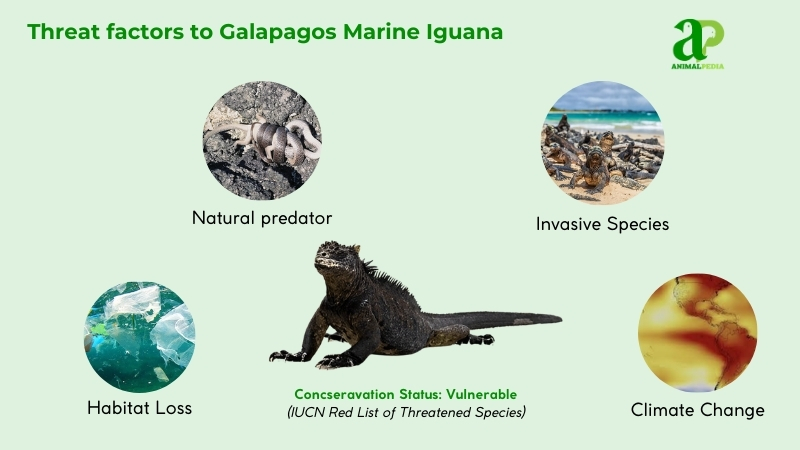
Natural predators vary by life stage. Hatchlings face predation from Galapagos hawks, racer snakes, short-eared owls, herons, and crabs. Adult iguanas occasionally fall prey to hawks or sharks. The Charles Darwin Foundation (2022) emphasizes that human-introduced species create ecological imbalances where iguanas lack evolved defenses.
Conservation efforts prioritize predator control programs and habitat protection, but significant challenges persist in preserving this unique marine reptile species.
Are Galapagos Marine Iguanas endangered?
The Galapagos marine iguana (Amblyrhynchus cristatus) is Vulnerable, not endangered, according to the IUCN Red List’s 2019 assessment. Their status reflects extinction risk due to restricted habitat and population fluctuations. Of the 11 recognized subspecies, six are Endangered and four are Critically Endangered, showing varied conservation needs across populations.
Major threats include invasive predators (feral cats, rats), habitat disruption, and climate-driven food scarcity. El Niño events particularly devastate populations by reducing algal food sources, causing 10-90% mortality during severe episodes.
Population estimates vary widely from 19,800 to 300,000 individuals. Recent research by Valle et al. (2023) using drone surveys estimated 22,000-210,000 iguanas archipelago-wide. Distribution is uneven – Fernandina Island supports robust densities (up to 8,000 per km), while San Cristóbal’s colony has dwindled to approximately 300 specimens. Miralles et al. (2017) suggested higher numbers (200,000-300,000) but confirmed declines in areas with heavy predation.
The Charles Darwin Foundation reports colonies stable but vulnerable, highlighting the need for subspecies-specific conservation strategies and continued monitoring across the Galapagos archipelago.
What conservation efforts are underway?
Conservation efforts for the Galapagos marine iguana focus on mitigating threats like invasive species and climate change. The Galapagos National Park Directorate (GNPD) and Galapagos Conservancy lead initiatives, notably the “Iguanas from Above” project, launched in 2019 by Leipzig University and the Galapagos Conservation Trust (GCT). This uses drone surveys to monitor populations annually during the reproductive season (December–March), providing data on 11 subspecies across the archipelago. Successful stories include stable populations at Playa de los Perros, Santa Cruz, reported by GNPD in 2020, with consistent numbers since 2013.
Legal protections stem from Ecuador’s 1959 decree establishing the Galapagos National Park, covering 97% of the land and marine reserves since 1998. The 1978 UNESCO World Heritage listing and CITES Appendix II status prohibit hunting, trade, and habitat destruction. Specific bans include introducing non-native species—feral cats, dogs, and rats—enforced by GNPD to curb predation on iguanas and eggs.
Breeding programs are limited due to the species’ specialized diet, with no widespread captive success. However, the Charles Darwin Foundation (CDF) supports habitat restoration, indirectly aiding natural breeding. A notable triumph is the Española subspecies (A. c. venustissimus), whose vibrant population persists despite competition for nesting sites, as per GCT’s 2023 reports. GNPD’s invasive species control, like rat eradication on Pinzón Island by 2012, has boosted hatchling survival rates from near-zero to 60–70% in some areas, per CDF data (2022). These efforts, backed by GCT’s Plastic Pollution Free Galapagos program since 2019, underscore a multi-faceted approach yielding measurable recovery for this Vulnerable species.
Frequently Asked Questions
Do Galapagos Marine Iguanas Have Any Unique Adaptations for Swimming?
Yes, Galapagos marine iguanas have unique adaptations for swimming. They possess flattened tails for propulsion in water, specialized salt glands to expel excess salt from ingested seawater, and reduced limbs for streamlined movement while swimming.
What Is the Lifespan of a Galapagos Marine Iguana in the Wild?
In the wild, a Galapagos marine iguana’s lifespan can vary, ranging from 5 to 12 years. Factors like food availability, predation risks, and environmental conditions play a role in determining their longevity.
Are There Any Differences Between Male and Female Galapagos Marine Iguanas?
Yes, male and female Galapagos Marine Iguanas differ in size and coloration. Males are typically larger with brighter colors, while females are smaller and less colorful. These distinctions help the iguanas attract mates and establish social hierarchies.
Do Galapagos Marine Iguanas Have a Specific Mating Season?
Yes, Galapagos marine iguanas do have a specific mating season. It occurs during the cold and dry months. Males display vivid colors to attract females. So, if you’re planning a trip to observe their romance, aim for the right time!
How Do Galapagos Marine Iguanas Regulate Their Body Temperature in the Ocean?
To regulate body temperature in the ocean, you, Galapagos marine iguanas, bask in the sun. By absorbing warmth from rocks, you raise your body temperature. After swimming, sunbathing helps you maintain and balance your internal heat levels.
Conclusions
The Galapagos Marine Iguana is genuinely an extraordinary creature with its distinctive appearance, habitat, and behavior. From their streamlined bodies and specialized teeth to their ability to thrive in rocky coastlines and form strong social bonds, these iguanas are truly intriguing. With adaptations and resilience against threats, they are proof of the marvels of evolution. Keep delving into the incredible world of the Galapagos Marine Iguana and learn more about these fascinating creatures!





